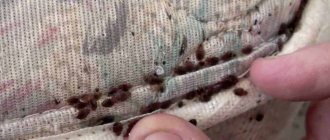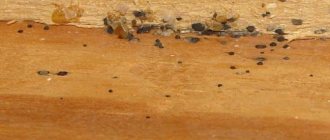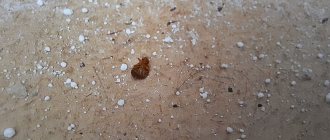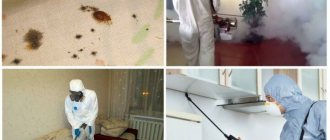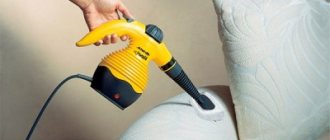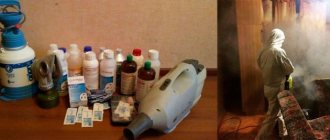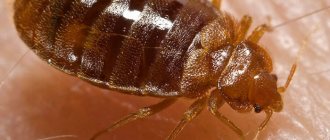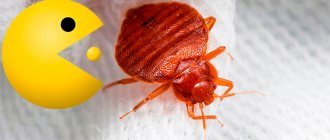Bedbugs are pests that can make life miserable. Getting rid of bedbugs can be difficult, so it is better to prevent their appearance in the apartment. Natural questions arise about how they appear in the house, whether bedbugs can be carried on clothes and other objects, or whether they are acquired in other ways.
Small bloodsuckers can appear in any home, no matter how clean and tidy it is maintained. It is a mistake to think that bedbugs only live in the homes of the marginalized or the dirty. They also live in places where garbage is not allowed and they clean up regularly. They do not start on their own, but enter the apartment from the outside.
How do bedbugs get into the house?
There are two options:
- the residents themselves come from their neighbors;
- they are brought by family members in different ways.
Bedbugs need several conditions to live and reproduce: suitable temperature, lack of high humidity, darkness, the opportunity to hide and, of course, a source of food, that is, a person. If your neighbors decide to poison bedbugs, some of them will die, and some will migrate to you. They also come to neighboring living quarters when there are too many of them in the previous one. Infection from neighbors is the most common cause of bedbugs.
Bedbugs do not travel very long distances. They are unlikely to come on their own from another house. But within the same building they migrate. It is often difficult to drive them out, because when there is danger, they go to neighboring apartments or non-residential premises, wait out the threat there, and then return back. This is especially true for old buildings, where bedbug colonies can live for decades despite control.
Neighbours
This situation is typical for apartment buildings. If your neighbors have bedbugs, they can easily crawl from apartment to apartment. Focusing on their excellent sense of smell, bedbugs will enter your home through the slightest cracks in the ceiling, walls, or through ventilation and sockets.
At the same time, if neighbors begin pest control, the remaining bedbugs can migrate en masse into your apartment. In this case, it is important to act together and carry out disinfestation at the same time. Most likely, your neighbors will warn you in advance about the impending disinfestation and ask you to carry out the treatment themselves - if the parasites run away to you, then nothing will prevent them from returning back in a couple of months.
Herbs and “smelling” household chemicals can also be used as a preventive measure. Bedbugs cannot tolerate strong and pungent odors due to their sensitive sense of smell. Wormwood, tansy, kerosene, denatured alcohol, turpentine - all of these products can be used to treat potential entry points. Since the effectiveness of such products is not very high, it is recommended not to skimp on a good insecticide - high-quality prevention will cost less than complete removal. The most accessible and convenient tool is Mashenka chalk, which can be used to circle all suspicious areas. A mosquito net should be installed over the ventilation holes.
How bedbugs are brought into a home
But bedbugs are also brought home by household members themselves in one way or another. It is enough to bring a couple of adults or live eggs for the population to quickly increase and take over the house. One fertilization is enough for the female to lay up to five eggs every day throughout her life. That is, the number of bedbugs is growing exponentially.
How to bring bedbugs into the house:
- on furniture - this is the second most common source of infection; This is especially true for used furniture, but you can also get parasites in a sofa or chair from a furniture warehouse;
- on purchased or received as a gift used and new clothes, bed linen, including those in original packaging;
- on suitcases and other types of luggage from hotels or transport;
- on domestic animals - when there are people, bedbugs rarely bite cats and dogs, but they can use them as a vehicle for migration;
- on clothes and shoes, bags used by family members.
Bedbugs prefer clothes in which they can hide. They will not sit on the surface, but will try to hide in folds, seams, folds, pockets of clothing, etc.
What is the danger for children and pregnant women
The presence of a large number of insects in the house can lead to the development of various phobias, to which children are especially susceptible. The thought that there is a bedbug somewhere nearby can cause psychological problems and cause insomnia. If the situation does not change for a long time, chronic fatigue and symptoms of severe stress appear.
Danger for children and pregnant women.
The main reasons why bedbugs cause more harm to children than adults:
- A child is more likely to become a victim of bites because he has thinner skin, so he is preferable to insects as a victim.
- Incompletely developed immunity causes a high risk of contracting an infectious disease.
- An adult can drink up to 3 g of blood on average. If there are a lot of parasites, then this amount of blood loss is significant for the child, and symptoms of anemia are noticeable.
Danger for pregnant women:
- Decreased immunity due to sleepless nights.
- Irritability that occurs due to discomfort caused by bites.
- The possibility of becoming infected with a vector-borne disease and subsequently passing it on to a child.
Where can you get bedbugs on clothes?
Bed bugs can be brought on clothing from a variety of places. Most often these are places of temporary stay - hotels, sanatoriums, hospitals, long-distance transport. Bedbugs do not move long distances. But they can crawl onto items of clothing. Insects are very small and easy to miss.
They can also lay eggs there, which are even smaller in size. This doesn't take much time. It is enough to spend one night in a hotel or spend several hours in a train carriage to bring bedbugs home on your clothes. You can also bring bedbugs on your clothes from regular transport or, for example, from a queue at a government office, where they can crawl from one person to another.
Children who attend kindergartens, hospitals, medical institutions, and children's health camps often bring bedbugs on themselves. There, of course, they monitor sanitary cleanliness, but no one knows in what conditions the other children live, whether they bring bedbugs on their things.
So, there is no 100% guarantee that you won't bring home bedbugs on your clothes, no matter what precautions you take.
Take care of your protection in advance
A prudent person thinks ahead and worries about how not to bring bedbugs home even before the trip. And here's the first piece of advice: don't take the problem lightly. If anyone thinks there is nothing to worry about, then they probably just haven't encountered bed bugs yet. The sharp increase in the number and spread of bed bugs is by no means an exaggeration, but a disappointing reality.
Look online for reviews of the hotel you are planning to stay at. Although you can't completely rely on reviews, if more than one person writes that there were bedbugs in the hotel, this is an alarm bell.
You can also call the hotel in advance, tell the manager of your concerns about bed bugs, and ask what protective measures the hotel is taking. Most likely, they will assure you that there are no problems with bedbugs in the hotel, but you can’t count on honesty in such a matter.
Do bedbugs live in clothes?
These pests try to stay close to humans. They are nocturnal and go hunting when the prey is asleep. The rest of the time they hide in secluded places, but do not go too far from the food source. Most often, they live inside the sleeping area - on the mattress, in bedding and accessories, inside a sofa or chair, on the backs of furniture, behind baseboards next to the bed, or even inside lampshades or picture frames located nearby. If there is a wardrobe or chest of drawers nearby, then they can live there, including on items of clothing. They can live in things for a long time: it’s warm, dry, and from there you can go out hunting at night and remain unnoticed.
What clothes can bedbugs be found on?
Insects can hide on any surface - smooth or textured. But they do not move well on fur or materials with long pile. They can be found on natural and synthetic fabrics - the composition of the material does not matter at all.
If a closet with clothes is infested with bedbugs, they can be seen everywhere - on underwear, pajamas, light shirts or blouses, and outerwear. Bed bugs prefer dark and secluded places, so they try not to stay on the surface, but climb inside: into pockets, into seams, behind lapels. They do not know how to gnaw through fabric, so they hide where they can crawl outside.
The bugs themselves do not spoil clothes, they do not gnaw them, and do not leave marks or snags with their paws. But if you crush a bedbug on fabric, a red or brown bloody stain may remain if the pest has not yet had time to digest the food. There may also be spots from excrement.
Females lay eggs, as if gluing them to the surface with a sticky secretion. Thanks to this, eggs can be located anywhere, including on inclined or vertical surfaces. It’s not always easy to just brush them off; sometimes you have to use a hard brush to do this.
Safety measures when returning home
If no bedbugs were seen during the trip, this is not a 100% guarantee that they did not come with you in your bag. These nocturnal insects are cautious and secretive, so when you return home, carry out control measures.
Washing and heat treatment
When unpacking things at home (even those that you haven’t used), immediately put them in the washing machine and turn on the wash cycle at 60 degrees or higher. Bed bugs cannot withstand this temperature and die. For delicate items, steaming or dry cleaning is suitable. Inspect the suitcase or bag carefully, clean it with a vacuum cleaner and cover it in a plastic case; store the suitcases not in the living room, but in the garage or on the balcony.
To prevent bed bugs from ruining your travel experience, stay vigilant and follow the rules outlined here. We wish you never to encounter these annoying parasites.
What to do if you see a bug on your clothes
As soon as you notice a pest, you should immediately put the item of clothing in a high-temperature wash. It is likely that there may be other parasites or eggs on the garment that may not be noticed due to their small size. To destroy them all, it is better to wash your clothes.
You also need to carefully examine the apartment to understand whether you brought this single bug on your clothes from somewhere or whether there is already a colony of parasites in your house.
First of all, you need to inspect the sleeping area. A bedbug nest can be found under the mattress, on the headboard of the bed, between the sofa cushions. It is also necessary to examine all nearby cabinets, chests of drawers, and cabinets. You can find them behind baseboards, peeling wallpaper and in other secluded places where hundreds of adults and eggs can parasitize. In addition to insects, excrement, pieces of shells and other debris can be seen in the nest. The habitat of bedbugs usually emits an unpleasant odor.
If you find bedbugs, you must immediately begin to fight them. You can call processing specialists or do it yourself. There are product concentrates for this, for example, Ziper, Permifen, Super, Neo from Medilis. Ready-made spray products are very convenient to use, for example, Medilis-superpower for bedbugs. The MediLIS laboratory specially developed this tool to work on resistant populations of bedbugs. Medilis-superpower against bedbugs was tested in real conditions on particularly resistant bedbugs. The test results exceeded all expectations. The motto of this line: “Helps where nothing else helps.” There is no need to treat clothes with insecticides. They are used to spray or wipe furniture and hard surfaces. Processing must be carried out in strict accordance with the instructions and safety precautions must be observed.
Appearance of bloodsuckers
Bedbugs are small insects 3-8 mm in length. Most often they are brown in color - from light to dark. After the blood is pumped, they acquire a reddish tint or turn black. The lifespan of an individual is one year. The female is capable of laying up to 500 eggs and in 40 days many new specimens hatch from them.
If there is a shortage of food, they can hibernate and emerge from it when favorable conditions arise. When the temperature drops to minus 15, the insect dies. The bug emits a characteristic odor when crushed.
How to remove bedbugs from clothes
Bedbugs can live in clothes for a long time. Getting rid of bedbugs on a person's clothing is quite simple. They absolutely cannot tolerate very low or very high temperatures. The traditional method of controlling bedbugs is freezing. Any items infested with bedbugs should be taken out into the cold. In winter, all windows and doors in houses are opened for this purpose and left overnight. At temperatures below -10 degrees, all parasites and eggs are guaranteed to die. This is impossible to do in the conditions of an apartment in an apartment building. But you can take your clothes out to the open balcony and leave them there for several hours or all night.
Also, bedbugs die at temperatures above +40 degrees. This means you need to treat clothes against bedbugs at this temperature. There are several ways to do this. The easiest one is to wash it. There is no need to add insecticide. Bedbugs will die from exposure to temperature. The powder will wash them off your clothes. This kind of processing is sufficient. To be sure, you can iron the items of clothing with an iron on both sides.
If clothes have been lying in one place for a long time, during which time tens and hundreds of individuals have managed to reproduce on it and make a nest there, then the item needs to be cleaned especially carefully. First, the bedbugs are brushed into a sealed bag and thrown away. Then the item is washed at high temperature, using a stain remover if necessary. After washing, you need to carefully inspect the seams where dead insects or eggs may remain. They need to be removed if they were not washed off with water during washing, and the item should be rinsed again.
Another way is to treat things against bedbugs with a steam generator. This way you can destroy bedbugs even on things that for some reason cannot be washed.
If the clothes cannot be washed or steamed, you can try this method: put the item of clothing in a sealed bag, spray it with insecticide and leave it for several hours. Then shake it very thoroughly, brush it and ventilate well. This method is usually suitable for outerwear with complex elements, zippers, hoods, hats, and shoes. If the item of clothing is in direct contact with the skin, this treatment should not be carried out.
If the apartment is infested with bedbugs, all clothing must be treated. It is taken out from storage places - from cabinets, chests of drawers, cabinets. Furniture must be wiped with insecticides, then washed and dried. Place clothes only in furniture that is clean and treated for bedbugs. Otherwise, the infection will recur.
Traditional methods
There are folk ways to prevent and expel insects from their homes.
Important! Keep in mind that almost 90% of the “blood-sucking population” lives within a couple of meters of the bedding area.
- Bloodsuckers have a keen sense of smell, so you can use fragrant herbs: calamus, chamomile, peppermint, tansy, wormwood and wild rosemary.
- Insects die at temperatures below 20 and above 60 °C.
- Sometimes it helps to spray with a solution: dilute turpentine, kerosene, liquid soap and warm water in a ratio of 10, 15 and 100 parts, respectively. Be careful, use protective equipment!
Attention! Tansy, wild rosemary and wormwood are poisonous and dangerous for children and animals.
It’s easier, safer and cheaper to turn to the sanitary and epidemiological station for help in exterminating insects: the result will be guaranteed.
Why do you need to treat clothes for bedbugs?
If you find bedbugs on items of clothing and cannot get rid of them, they will crawl closer to the sleeping areas and will live there, multiply and annoy everyone in the household.
If suddenly you find not an adult bedbug, but an egg on your clothing, treatment is also necessary. No one can guarantee that there are no other parasites in the apartment.
In addition to the question of whether bedbugs can live on clothing, many are also interested in whether bedbugs can bite through clothing. The answer is clear - no. While sleeping, pajamas protect against bedbug bites, but insects bite where the skin is not covered by anything. If the pest is on the fabric, it simply cannot bite through it to get blood. Its mouthparts are not designed for this. The bug pierces the skin and drinks blood from a shallow depth - from capillaries, and not from vessels or veins. It doesn't have teeth to chew anything. Therefore, bedbugs on clothes themselves do not pose a danger. But once they get into a room where there is furniture and other secluded places near a sleeping person, they will move from the clothes there. It will be much more difficult to get them out of bed-bed-sofa than from clothes.
Bedbugs on clothes are not only a way to infect your apartment with bloodsuckers - in this way you transfer the pests further. They can get from your clothes onto the clothes of other people in transport, shops, queues, or just on a bench. They cannot jump, but it is enough to sit next to the source of infection for a while for the insect to simply move on to a new victim. To prevent this from happening, you should periodically inspect your closets and clothes, and if you find bedbugs, immediately begin fighting them. To help in the fight - a line of ready-made or concentrated products for preparing working solutions from the manufacturer MediLIS Laboratories.
Features of the use of chemical insecticides
The industry produces a variety of products against blood-sucking insects. Fabrics can be treated with aerosols Karbozol, Perfos-P, Raptor, Raid, Clean House, Combat.
When using them you need to follow some rules:
- Carry out processing away from food, it is better to do it on the street or balcony.
- It is advisable to wear a mask to protect your respiratory tract before spraying clothing.
- After the effect of the drug wears off (see instructions), wash the treated item if possible.
The bug is a creature that multiplies quickly and is surprisingly tenacious, so treatment to destroy it must be carried out as carefully as possible and at the first detection. Today we answered the following questions: do bedbugs live in clothes and how to get them out of there?
If you find an error, please highlight a piece of text and press Ctrl Enter.
